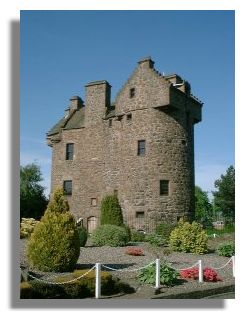
Introduction
Claypotts Castle has a lot going for it. First, although its design is not unique (Burleigh Castle in Perthshire, for example has a somewhat similar arrangement), the square rooms on top of its towers make it unusual. Secondly, for a 16th century castle, it is in a very good state of repair. Clearly it was not a major fortification which came under attack or needed to be blown up to save it from falling into the hands of some enemy. Lastly, it is easy to reach, being on the edge of Dundee (indeed, it is now surrounded by modern suburban housing!). The castle is a Z-plan tower house with a rectangular main block and two round towers at opposite corners. It is the square, gabled chambers on the top of these towers which give it such a distinctive appearance.
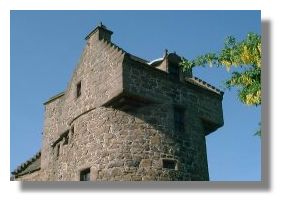
Who Built It?
Although fortifications at Claypotts were built "only" between 1569 and 1588, the lands of Claypotts were given to the abbey of Lindores by Alexander II before 1247. In the beginning of the 16th century the lands were held by a tenant of the abbot of Lindores, John Strachan. Not that Strachan was a particularly upright man - in 1511 he was involved the theft of seven horses and wagons from the chancellery of Dunkeld!
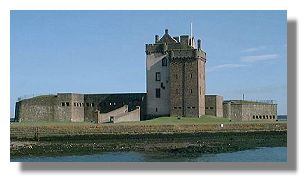 In 1547, there was one of the many invasions of Scotland by the English, this time as part of the "Rough Wooing" when the English king demanded that his son Edward VI (aged 10) should marry Mary Queen of Scots (aged 5). Nearby Broughty Castle (pictured here) was occupied by the English until 1549 and during that time the Strachans of Claypotts would no doubt have suffered at the hands of the invaders. This may have encouraged the family to fortify their home but it was not until between 1569 and 1588 that the towers at each corner of the castle were built. The supports for the room above the north tower has a date of 1588 inscribed on it.
In 1547, there was one of the many invasions of Scotland by the English, this time as part of the "Rough Wooing" when the English king demanded that his son Edward VI (aged 10) should marry Mary Queen of Scots (aged 5). Nearby Broughty Castle (pictured here) was occupied by the English until 1549 and during that time the Strachans of Claypotts would no doubt have suffered at the hands of the invaders. This may have encouraged the family to fortify their home but it was not until between 1569 and 1588 that the towers at each corner of the castle were built. The supports for the room above the north tower has a date of 1588 inscribed on it.
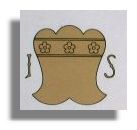 The castle we know today was built by a second John Strachan who married a Eufame Durham from a neighbouring estate. The couple had seven children and John Strachan had his own coat-of-arms (in the picture here - with his initials incorporated in it). John lived to enjoy his castle until 1593 and was succeeded by his son Gilbert and then his grandson, the third John Strachan.
The castle we know today was built by a second John Strachan who married a Eufame Durham from a neighbouring estate. The couple had seven children and John Strachan had his own coat-of-arms (in the picture here - with his initials incorporated in it). John lived to enjoy his castle until 1593 and was succeeded by his son Gilbert and then his grandson, the third John Strachan.
By the start of the 17th century the Strachans began to move away from Claypotts and it was sold to a member of the Graham family in 1601. Later in the century it was inherited by John Graham of Claverhouse, Viscount Dundee, one of the famous names from Scottish history. But this soldier, statesman and loyal supporter of the Stewart kings probably spent little time at Claypotts.
After the death of Viscount Dundee at the Battle of Killiecrankie (which ended any hopes of the Stewarts returning to the throne), the castle was forfeited to the crown. But in 1694 the property was granted to James, second Marquis of Douglas for services to the king (William of Orange). In the 19th century the castle passed by marriage to the twelfth Earl of Home (a mainly Borders family). The Homes passed it to the state in 1926 and it is now maintained by Historic Scotland.
Visiting Claypotts
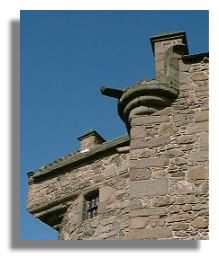 Claypotts is just south of the A92 Arbroath Road, the main road which skirts north of Broughty Ferry. While it is possible to wander round the outside of the castle at any time, access to inside the castle is limited. It is best to check with Historic Scotland in advance if you want to view inside the castle. But, of course, Broughty Castle is not far away and it is open till 5pm most days (but closes between 1pm and 2pm).
Claypotts is just south of the A92 Arbroath Road, the main road which skirts north of Broughty Ferry. While it is possible to wander round the outside of the castle at any time, access to inside the castle is limited. It is best to check with Historic Scotland in advance if you want to view inside the castle. But, of course, Broughty Castle is not far away and it is open till 5pm most days (but closes between 1pm and 2pm).



